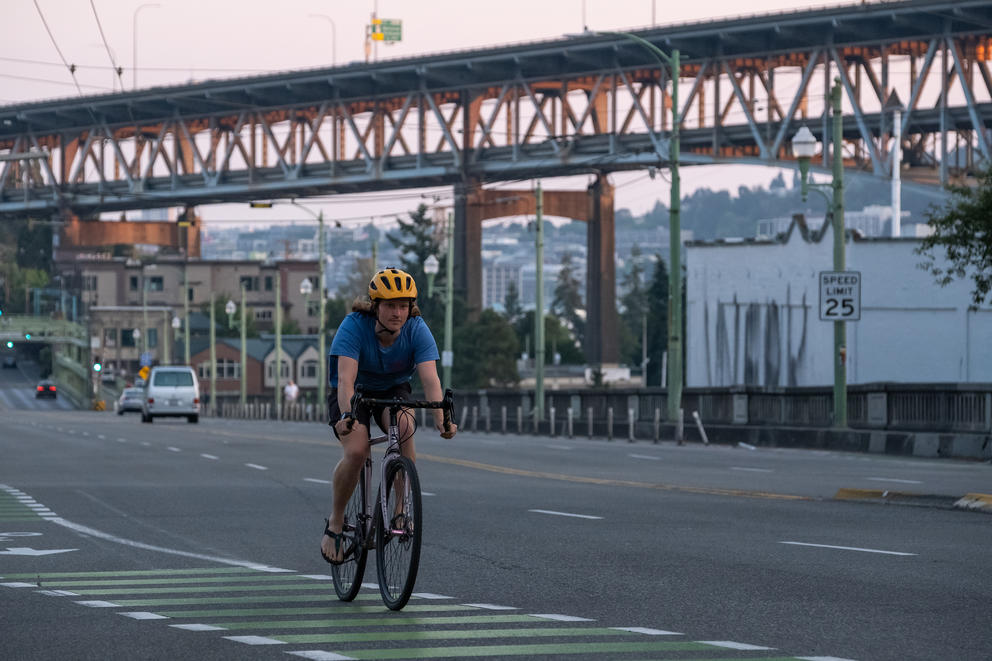The proposal, which Harrell called “clearly the biggest levy in our history,” would add $148 per year to a median homeowner’s property tax bill.
In his speech announcing the proposed transportation plan, Harrell emphasized the need for safety for all modes of travel.
“As mayor we wanted to create a city that’s safe for all people. Whether public safety in terms of crime or transportation safety, it is all about making sure we can be who we want to be in a safe environment,” said Harrell on Thursday.
He continued, “This bashing of modes of travel will not happen under a One Seattle approach. We need safe, reliable, connected transportation systems that will recognize that.”
The plan would spend about $423 million on repaving and street improvement projects on 50 of the city’s most heavily used streets. Many of those repaving projects would include multi-modal elements such as protected bike lanes, bus lanes and sidewalk repair.
Another $218 million would go toward bridge maintenance and repair. There are 135 bridges in Seattle and they’re getting up in years, with an average age of 60 years.
Transit riders would get a boost through a $121 million investment in bus-only lanes, priority traffic signals for buses, improvements to sidewalks, and lighting and crosswalks near transit stations and bus stops.
The plan proposes spending $109 million on sidewalk construction and repairs. Seattle has about 11,000 city blocks with no sidewalks. The renewed levy would build an additional 250 blocks of new sidewalks and 10,000 accessible curb cuts. In 2017, Seattle settled a lawsuit for violating the Americans with Disabilities Act with its lack of curb cuts, and agreed to build 25,000 additional curb cuts by 2035.
About $107 million would be dedicated to Vision Zero and school safety projects. The money would be spent to improve streets identified in the city’s “High Injury Network” as having frequent crashes and fatalities, such as Rainier and Aurora avenues.
The plan would spend another $100 million to modernize the city’s traffic signal systems and wayfinding signage.
Rounding out the $1.35 billion: $94 million for bike infrastructure; $57 million to activate street space for pedestrians through parklets, signage and more; $49 million for climate efforts such as street trees and electrified transportation; $48 million for neighborhood street projects; and $25 million for freight mobility.
The city’s current $930 million transportation levy was passed by voters in 2015 and is set to expire at the end of the year. It costs the median Seattle homeowner $435 a year in property taxes. Renewing the levy at $1.35 billion would add another $148 per year to that median homeowner’s property tax bill.
“This is big ball for what we’re trying to do — reflecting what we need to do and what kinds of investments we need to have to make sure our future is safe,” said Harrell in his speech.
Though the mayor’s proposal would be historically large, some transportation advocates say it falls short of what the city needs to spend to move the needle on street safety for all modes, along with climate goals.
The Urbanist reported that a coalition of advocates, including Disability Rights Washington, Seattle Neighborhood Greenways, Cascade Bicycle Club, Seattle Subway and others, put the price tag at more than $3 billion to build out sidewalks, transit corridors, bike lanes, crosswalks and signals citywide along with safety improvements on the city’s five deadliest streets.
Harrell emphasized Thursday that the proposal is still in draft form. The city is soliciting public feedback on the proposal until April 26. The mayor promised to incorporate that feedback into a final draft of the plan he will send to the City Council in May.
If approved by the City Council, the levy will appear on this November’s ballot.



